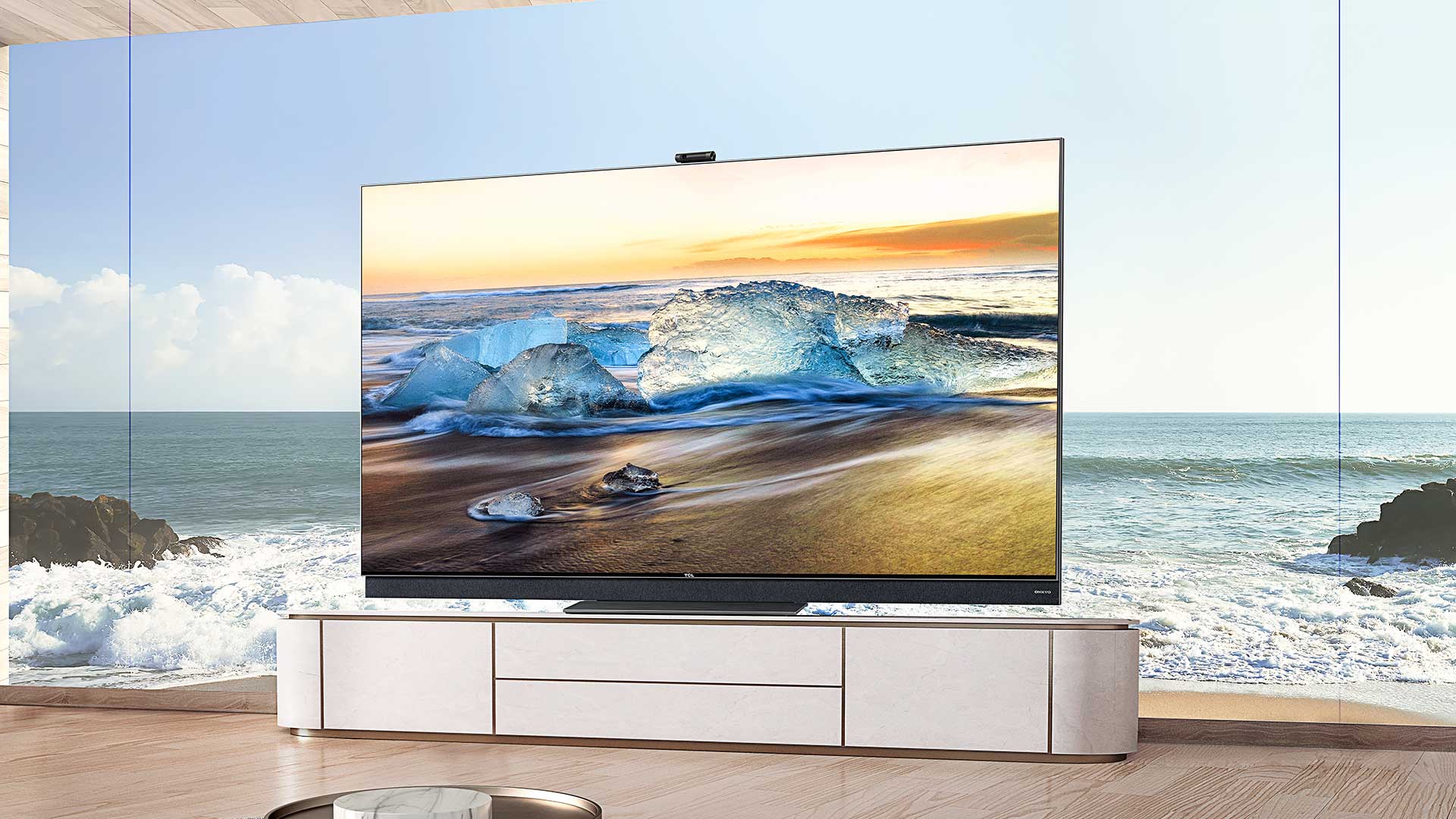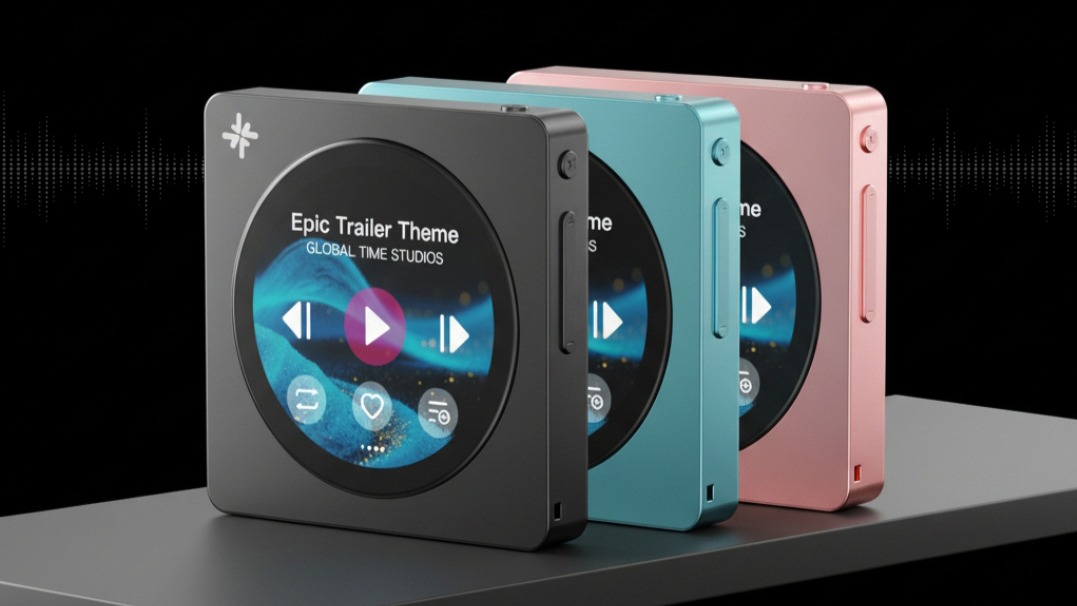Sound+Image Verdict
A flagship TV proves the merits of Mini LED and Google TV, and even keeps us on a rising appreciation curve for 8K resolution.
Pros
- +
Reference-level blacks
- +
Bright colours and whites
- +
Google TV interface
- +
Integrated soundbar
Cons
- -
Some early set-up issues
- -
How useful is 8K, really?
Why you can trust What Hi-Fi?
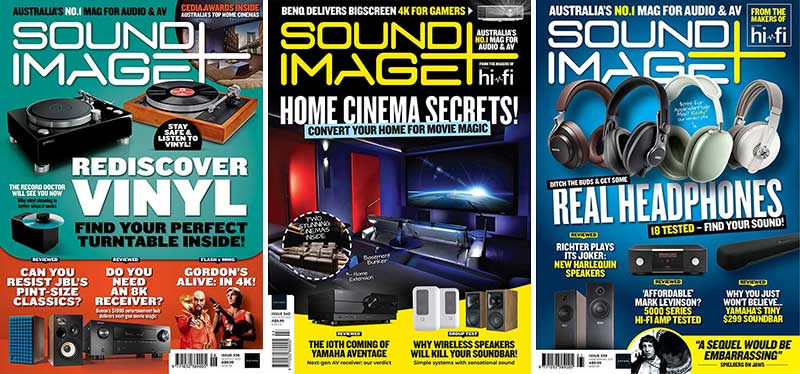
This review originally appeared in Sound+Image magazine, one of What Hi-Fi?’s Australian sister publications. Click here for more information on Sound+Image, including digital editions and details on how you can subscribe.
TCL is certainly packing in the technologies here for its flagship TV. It’s 8K, it’s Mini LED, it’s got Google TV, it even has a camera you can plonk on top, if you like that sort of thing.
It’s the company’s uppermost flagship, and has launched here in Australia before Europe, for once, so we’re delighted to be getting an early play with the 65-incher in TCL's X925 series, the 65X925.
Mini LED
While many people will be attracted by the Google TV interface, there’s no doubting that chief among the many technologies in the X925 is Mini LED. Mini LED breaks the usual LED backlighting into thousands of tiny LEDs, grouped in hundreds of dimming zones – 160 zones on this model, the same as on the 65-inch 4K model. The 75-incher has 240 zones.

Those backlights excite a Quantum Dot colour layer, behind an LCD panel that controls the light levels coming through.
All of which may seem a conceptually simple enough advance on the fewer zones, fewer lights of the past. But the many groups of mini LEDs allow extremely precise local dimming and, as we’ve found with other Mini LED sets from both TCL and Samsung, the effect is significant.
Indeed the technology achieves the same ability to display 0.001-nit brightness as OLED. It allows more stops of brightness than OLED, so a higher dynamic range and a brighter image available under daylight conditions. It achieves fully 100% of the DCI-P3 colour volume compared to around 70% for OLED. And there’s no risk of burn in with Mini LED.
What does that leave for OLED to crow about? Fewer reflections, wider viewing angles, and better performance when depicting tiny moving stars on a dark background (OLED can illuminate single pixels, which is currently beyond the ability of Mini LED). It’s no longer a whole lot to justify the higher prices of OLED sets.
The latest hi-fi, home cinema and tech news, reviews, buying advice and deals, direct to your inbox.
This is the third Mini LED TV we’ve had on trial, two of them being 8K, and we’re convinced. OLED screen technology certainly wowed everybody when it first arrived, because the dynamic range and zero blacks were spectacular against the LED TVs of the day – when it arrived. But not any more.

Google TV
One exciting first for us with the X925 was its inclusion of not only Android TV but Google TV – the first time we’ve seen it. While we expect many new Android TV devices to get Google TV in the near future, and for some older devices to get upgrades, TCL is nevertheless ahead of the pack here, its arrival joining only some Sony TVs and Google’s own Chromecast TV.
Although it’s primarily an overlay on Android TV (here Android 11, or ‘R’, for Red Velvet Cake), its home page is significantly different, based more around recommendations and voice search bringing together information from all the services to which you have subscribed.
The initial TV set-up is now through Google Home, where you find and link your new TV, and also tell Google what your subscriptions services are. Another Google TV bonus is enabling you to add shows or movies to a watchlist direct from a phone, tablet or computer, rather than having to click each one on the TV interface itself. To assist in this regard the Google ‘Play TV & Movies’ app is being rebranded as ‘Google TV’.
The cynics among us also point out that to enable these cross-service recommendations, you must give Google the ability to monitor everything you watch, one more set of data points to bolster their dossier on your life, likes and preferences.
Voice commands can be given by pressing the ‘Hey Google’ button on the remote – you don’t need to say ‘Hey Google’, so there shouldn’t be erroneous triggers from TV audio. We did experience a couple, though. Episode 2 of Squid Game was paused by Google trying to obey an instruction presumably triggered by the Korean-language soundtrack, which it interpreted as ‘Hey Google put my piercing on YouTube’. It didn’t succeed in this request (just as well, given the location of this reviewer’s piercing), but it did crash Netflix in the process, and rather spoiled the mood. Thankfully such misinterpretations seem far less common than in the early days of Google Voice, when we noted that Google was particularly prone to being triggered by Elvish in The Lord Of The Rings & Hobbit movies.
We should also mention that those more of the Alexa persuasion will be pleased to know that Jeff’s monitoring drone can also be enlisted for assistance.
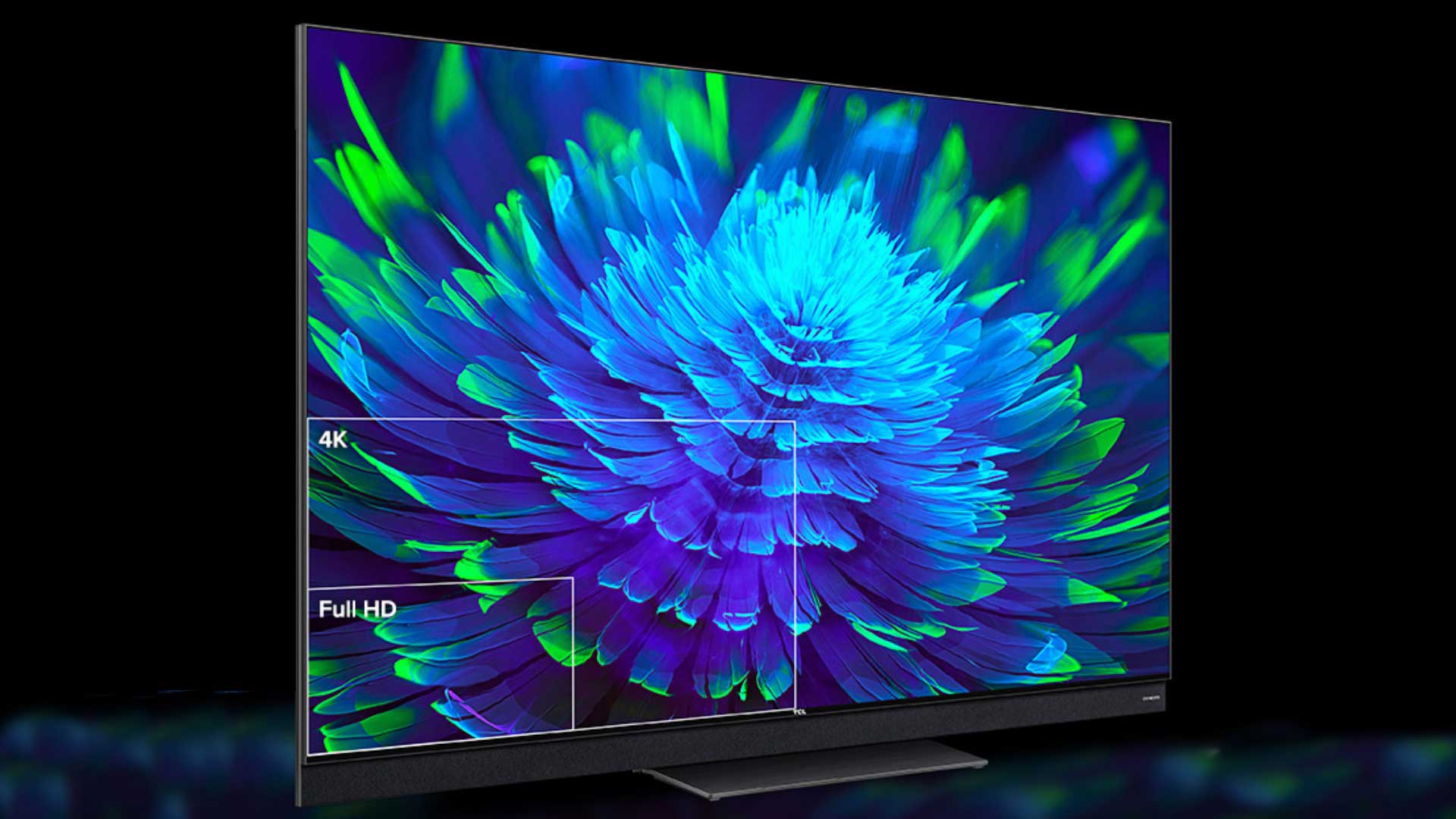
8K resolution
Let’s address that headline 8K resolution – 7680 pixels across by 4320 pixels down, precisely four times the pixel count of Ultra High Definition. When the first 8K TVs came out, we were fairly dismissive of the idea – there was no content, not much prospect of any content, and as TCL’s own presentation to EISA editors in mid-2021 admitted, 8K resolution is overkill even on a 75-incher, because the human eye can’t detect the additional resolution from any reasonable viewing distance. With a 120-inch screen you can’t discern 8K from 4K at three metres, reckons TCL, and with this 65-incher you’d have to sit within a metre of the screen for the higher resolution to be discernible.
Other benefits? Is the brightness higher, because there are more pixels? No, because they’re smaller – the quoted nit figure here is 1000, same as on the 4K C825.
So why bother with 8K? You could say future-proofing, as there are now the smallest glimmers of hope for native 8K content – via streaming, or from PS5 gaming.
Also we have lived with a number of 8K sets where the quality of upscaling has been so effective that there’s just something about them, though it’s hard to say what, so this may be ownership bias. Nevertheless, we’ve gradually been converted to 8K viewing.
Perhaps the most salient point is that 8K acts as an entry ticket to other premium technologies, since the 8K models inevitably represent the flagship range. Samsung has been particularly foxy in this regard – you can’t get its best processing technologies in a mere 4K TV, so you’re encouraged to buy 8K if you want the best. TCL, meanwhile, has a stated policy of technology democratisation – it tries to deliver everything it can at any given price. But clearly the top-of-the-line series, which this X925 very much is, comes loaded with the very latest and greatest technologies that TCL has to offer.
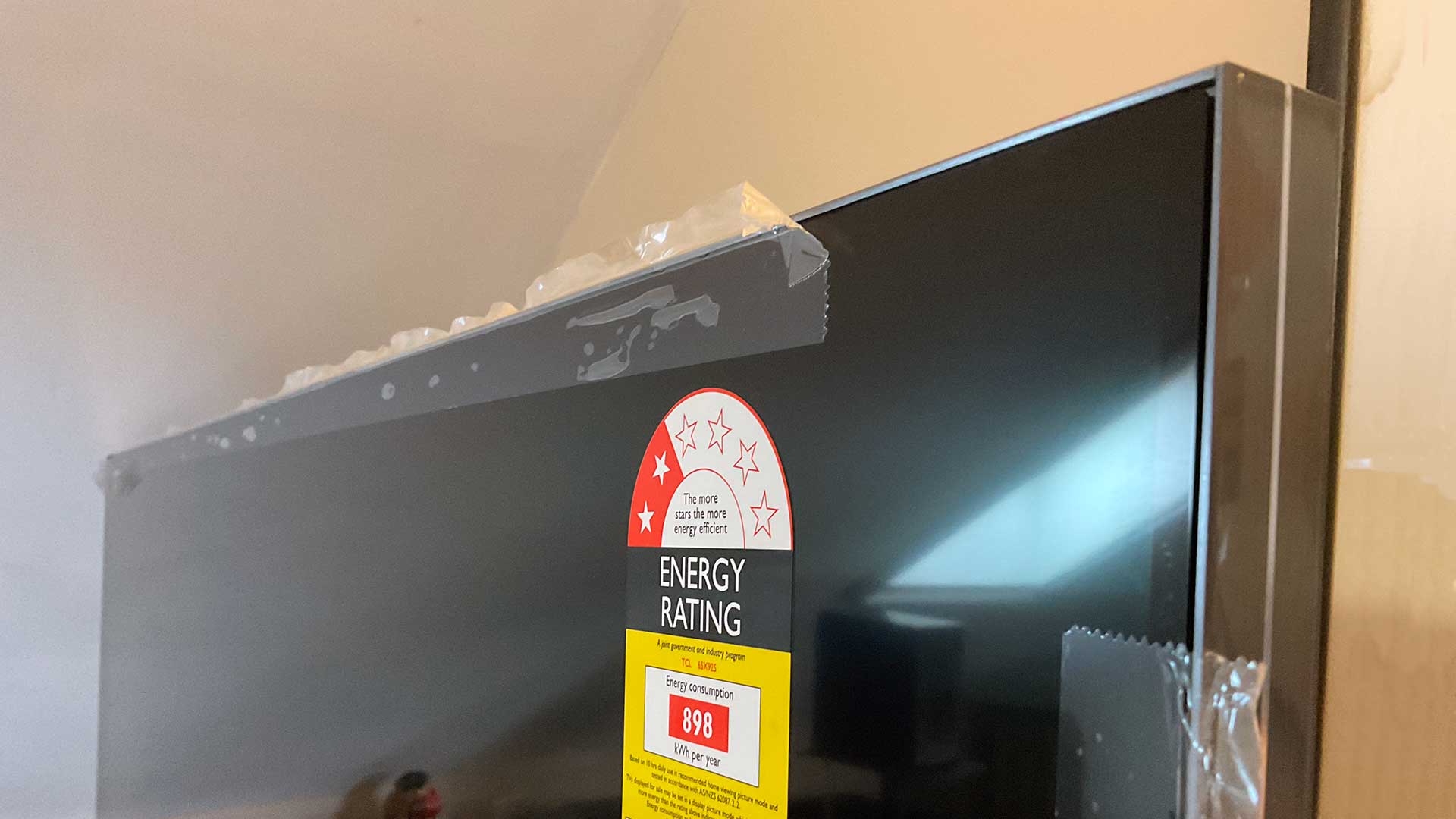
Set-up & sockets
We’ve reviewed some 65-inch TVs which a delivery team has carried up our entry steps at a light jog. Their faces were rather longer bringing up the 65X925. “Very Heavy” says a sticker on the box: “36.4kg”; the specs say 42.7kg. It’s still 34.5kg out of the box, once the stand is attached. Despite the weight, however, its unboxing is not difficult, and once we had it laid face down on a foam-lined sheet atop the box it came in, it was easy to attach the remarkably compact central stand.
The screen area itself had three stickers and four sides of peelable protective plastic all alarmingly stuck to its surface, but everything was fairly easily removed without leaving any marks – and card strips on the side had also prevented our own fingers making contact during installation.
As is TCL’s fashion, the sockets are all on the right side of the TV, which can be darned inconvenient if your room is previously set up for the more common left-side socket positioning. Partly for that reason we left everything plugged into our AV receiver (8K and eARC compatible) and ran a single and purportedly 48Gbps-capable HDMI cable over to the TCL’s HDMI input 4, the one marked for eARC connections, and so able to send both stereo and surround sound back to the receiver from its own apps while receiving 12-bit 4K up to 60Hz (4:2:2) under HDMI1.4b silicon.
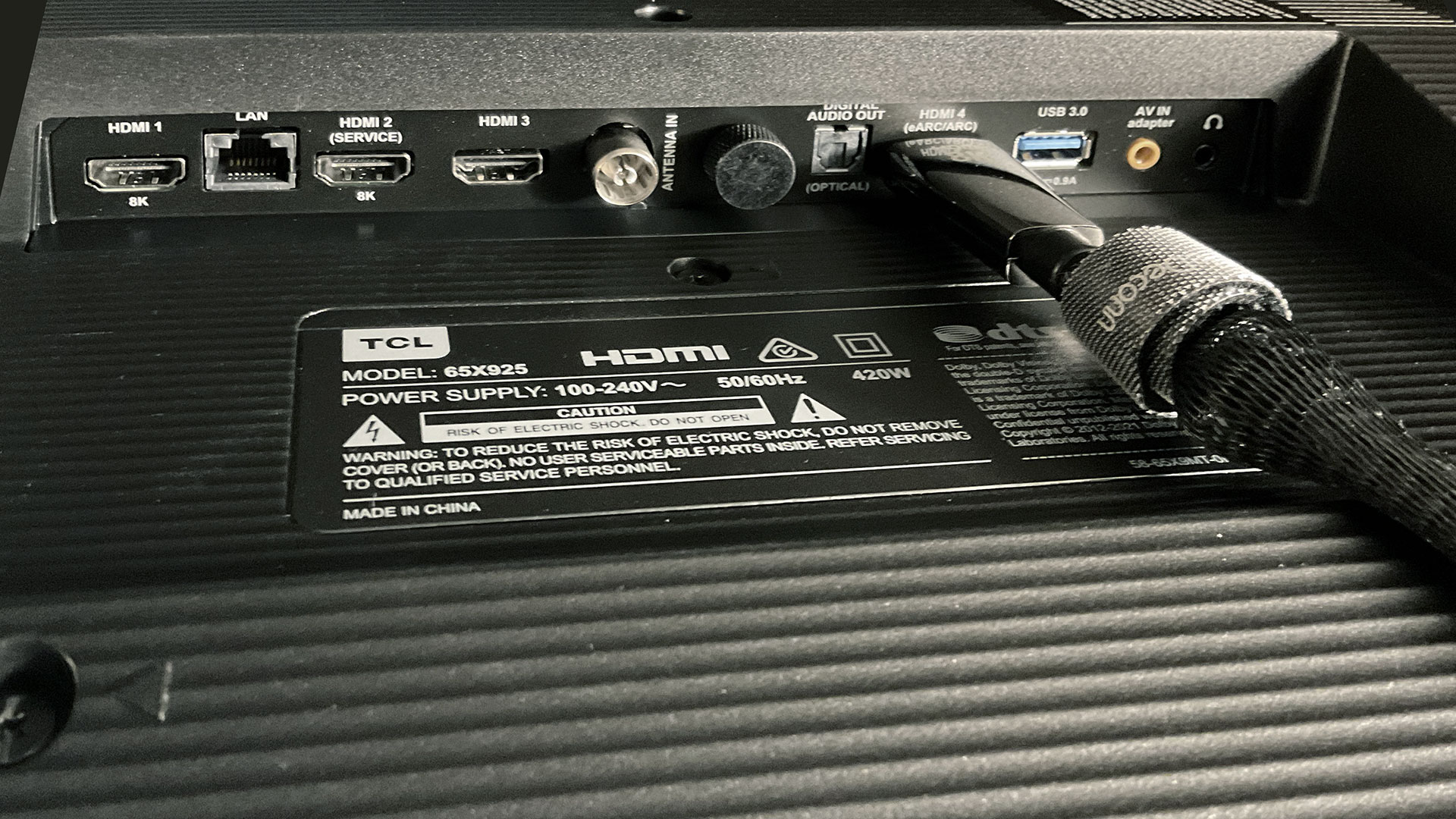
Those requiring further direct connections will find the three other HDMI sockets to include two marked for 8K HDMI 2.1 compatibility, should you live long enough ever have two 8K sources, up to 10-bit 8K@60Hz at 4:2:0, and the third unlabelled, presumably again HDMI 1.4b good for the highest forms of 4K. There’s no 3D compatibility.
There’s also a multishank minijack AV input for composite AV, with an adapter cable provided; also a USB 3.0 slot, antenna input, and audio out via both optical digital and analogue headphone minijack. You can give it Ethernet networking, but we went with Wi-Fi, which is specified as the blisteringly-fast dual-band Wi-Fi 6, with its theoretical speed of nearly 10Gbps, though 1Gbps is considered more realistic, still enough to stream 8K if that ever becomes more prevalent. Compressed OTT 8K is expected to settle down somewhere around 40Mbps, so the limit, once it comes, will be whether your modem is up to it and your NBN plan reliably rapid, not the abilities of this TV.
We must report that our original set-up suffered a good few problems. The initial interaction with the Google Home app worked fine, but once back in the TV menus we got stuck in a software loop, had an onscreen message that disabled progress, and an initial period of pitch-dark video replay. Eventually these were resolved by a series of restarts, and did not recur. We’re inclined to excuse this on the grounds of our review unit being an early arrival both for the TV and for Google TV; Europe, for example, is not getting TCL’s Google TV roll-out until their summer, nine months after us, so at this early time we’re surely something of a testbed.
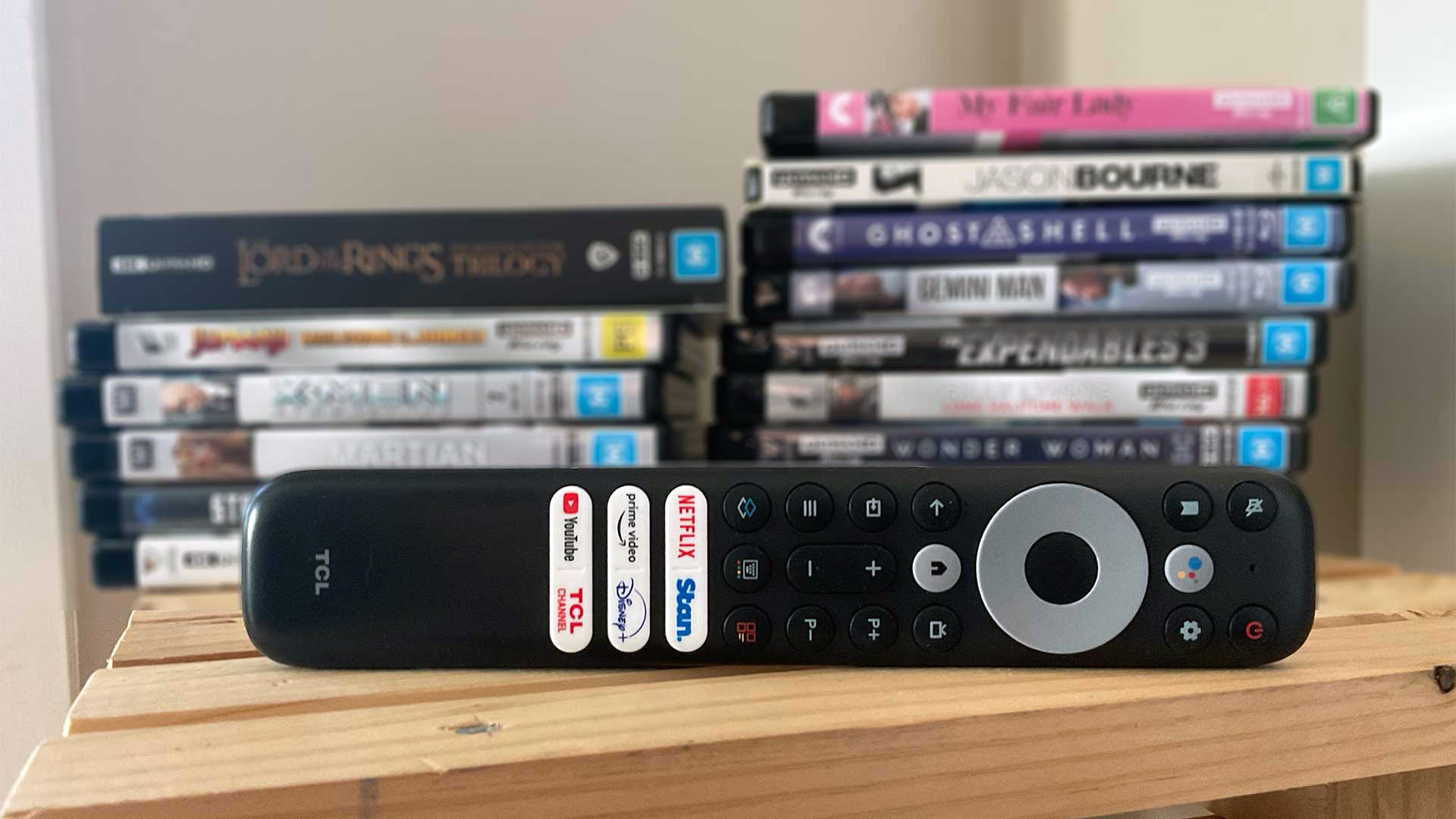
Performance
Though set-up had been something of a trial, finding our way to a fine picture was not. Having previously had TCL’s 55X825 Mini LED television in the same position, we knew our way around the settings menu and went straight to the ‘Movie’ picture mode, which is TCL’s equivalent of the filmmaker modes used by some other brands. These address Hollywood’s protestations against excessive processing, and motion interpolation in particular, smoothing motion by sometimes inserting so many created frames between the actual ones that what you see is more fake than real.
While we concur with the thinking behind Hollywood’s crie du coeur, we also appreciate the merits of some motion smoothing and de-blurring of cinematographic imperfection. So our initial path to a preferred TCL image was delivered by selecting Movie mode, then turning motion settings back on, and setting both blur reduction and judder reduction to a lowish 3 out of 10.
The other odd choice for nearly all ‘filmmaker’ modes is a very warm or yellow/brown palette, which we find highly unnatural, so we also entered the expert colour menus and returned this to ‘zero’ for more neutral results.
These settings delivered fine results for film-based content across broadcast, streaming and disc-based video, including standard-HDR 4K Blu-rays.
But in our dimmed viewing room we also sometimes invoked the ‘Low Power’ and ‘Smart HDR’ settings, which delivered some astounding results, especially on video-sourced streaming programming. Watching the Istanbul episode of Jack Whitehall’s Travels With My Father on the TV’s Netflix app in 4K, the exterior city shots were extraordinarily sharp, reminding us more of demonstration reels of cityscapes we’ve seen shown on OLED screens at launch events than of real-world programming. It was eye-popping stuff for both detail and colour. Given this set is upscaling it all to 8K, and that we’d tempered the sharpness setting to avoid ringing edges, this was simply excellent performance by TCL’s AiPQ Engine, which does the smart processing grunt-work here.
When you give the TCL material with Dolby Vision HDR, you lose a little control, as the TV locks into its Dolby Vision modes. Even here, though, there is a useful choice between Dolby Vision IQ, which takes account of ambient light in the room but removes your ability to customise motion settings, Dolby Vision High (too bright for our dimmed environment), and Dolby Vision Dark, which was our preference, especially as we could again fix the overly warm colour gamut. We’ve seen mention of a Dolby Vision Game setting, which leaves the tone mapping to the attached game console to improve latency; we didn’t have a next-gen console attached, so the Dolby Vision Game setting perhaps wasn’t offered. For gamers the X925 also supports Auto Low Latency mode, variable refresh rate to 120Hz, and AMD FreeSync.
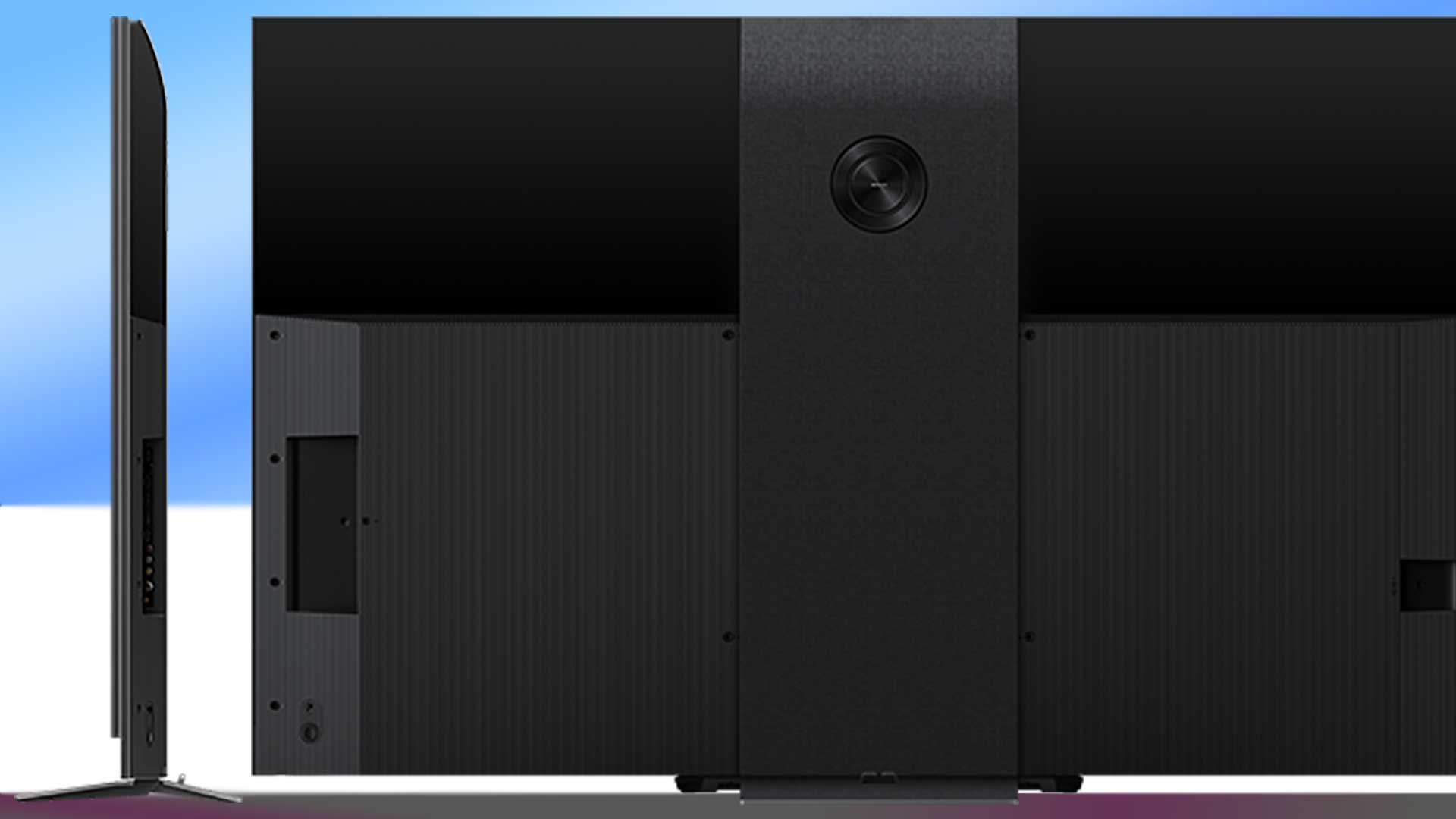
The most recent Jack Whitehall season is in Dolby Vision, and these stream at remarkably high bit-rates, double those of season 2. Again the detail was riveting, and now the colours were even more impressive – startlingly red flowers around a door, vibrant green English countryside. Only skin tones caused us pause, sometimes erring towards a pastey brown, but since this varied scene by scene, at times more accurate, we’re inclined to blame this on the off-the-cuff film-making and lighting conditions.
Meanwhile the Dolby Vision HDR could deliver a sunset blazing over London, while blacks remained genuinely black, not grey – again the kind of visual impact we usually see only from a high-level OLED panel. We do not remember (and our notes do not indicate) this level of hyper-reality when we reviewed the C825 from TCL, so perhaps there is something in this 8K presentation specifically. For assessment purposes we were sitting just over a metre from the screen for much of our viewing.
South Korea’s Squid Game comes in Dolby Vision, with Dolby Atmos sound as well, the latter unmolested in its journey to our external sound system, height information included. Meanwhile the TV delivered the opening scenes with high-detail realism, further heightened by the more binary colours adopted when the show moves to the game arena. How brightly fuschia the organisers’ costumes, how sombrely aqua the game players. In the external gameplay scenes, again how hyperrealistic the focus and detail. (Squid Game had just arrived on Netflix, its fame not yet established… and it was a mistake to randomly select this series as a Dolby Vision/Atmos tester, as we were still pinned watching seven hours later, interrupted only by drinks runs and that rogue Google intervention.)
Eventually we settled down and minimised our tweaking, though we did find ourselves regularly intervening to achieve perfection for different sources and streaming services. This need to fiddle isn’t ideal, though it would be minimised if you are using separate inputs for different devices, for which settings are stored individually (or universally if you prefer). We didn’t have that luxury, though, as all our sources – UHD Blu-ray, AppleTV 4K, HD PVR – were behind the Yamaha receiver connected to the TCL, so they shared one set of input settings. The TCL was also very keen on the AppleTV, and would wake it up via HDMI-CEC whether we wanted it or not, thereby activating that Yamaha input and interrupting other sources. HDMI-CEC can be too damned smart for its own good sometimes, and when we talked with TCL about this, they confirmed the complexities, citing the example of a user switching away from a Blu-ray player which later turns itself off through auto-standby, thereby triggering an entire system shut-down. HDMI-CEC implementation is always going to be a compromise, with certain scenarios proving annoyingly persistent.
Still, let’s focus on the picture quality here. With our preferences for Dolby Vision, movie and video content established, the X925 delivered consistently impressive images, and sometimes that eye-boggling hyper-realism that makes you almost gasp.
We should note that this set also supports HDR10+ high dynamic range (as used by some Prime HDR shows) and IMAX Enhanced (nothing available here of which we’re aware; all the IMAX Enhanced discs we have found are unavailable to Australia). In either case that’s more future-proofing for you.
External sound
Talking of latency, we initially experienced quite a lot of delay on the sound from Google TV apps travelling via eARC to our receiver. This was fixed by two things, one of them really rather remarkable.
First, under the ‘digital audio out’ settings we switched from ‘Auto’ to ‘Passthrough’. The latency was then almost acceptable, but not quite.
The second more miraculous inclusion is an audio delay setting which not only delays the audio, but which can go negative, which means delaying the video. We haven’t seen this ability since LG removed it from their TVs three or more generations back, and the reason it’s so rarely available is that delaying the video requires caching frames in memory, which was harder with 4K UHD than it was with standard definition, and you’d think would be a horrendous proposition with 8K frames, but here it is. Lipsync is one of our greatest bugbears at Sound+Image, precisely because devices like soundbars often delay the audio until it emerges after the video, but the only sync adjustment they offer is to delay the audio further. We can’t praise TCL enough for this inclusion. We nudged it back to -20 out of an available -50 (milliseconds?), and the sync was perfect.
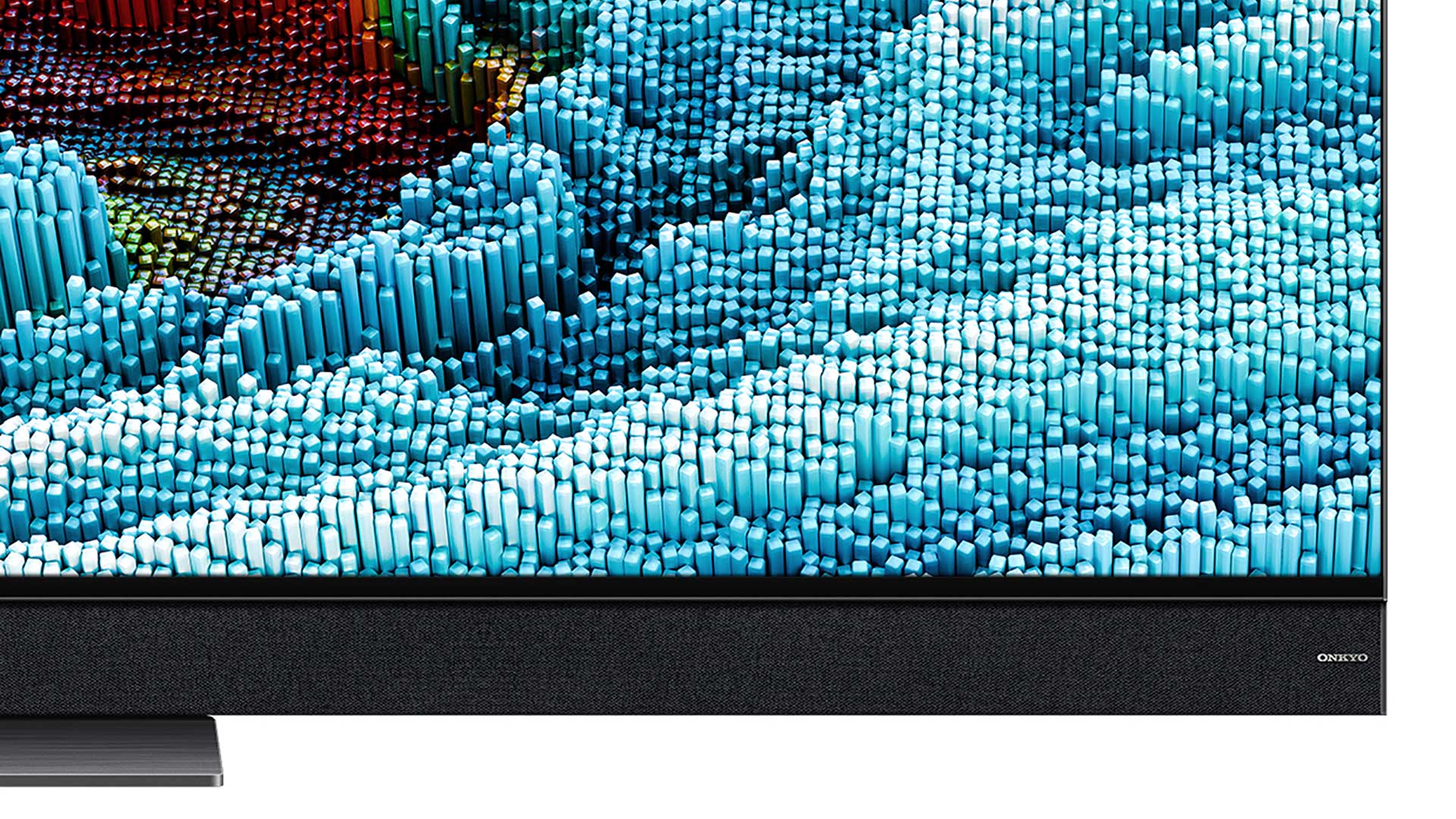
Built in soundbar
We always recommend that a good TV should be accompanied by a good external sound system. But TCL’s built-in soundbar, with Onkyo branding, does deliver something much more respectable than most built-in TV sound systems. In standard mode it sounded reasonable even with music, lacking dynamics but able to hold a tune at reasonable volume without becoming harsh, and with tone and mode controls which could add useful bass reinforcement thanks to the ‘subwoofer’ round the back of the TV.
Standard audio mode left dialogue a little soft, but ‘movie’ mode added some crispness and gave AppleTV+’s Foundation, say, a nicely wide and open soundstage, not going beyond the confines of the bar but separated and fairly powerful. Adding a soundbar, except the very best of the breed, would not improve things, although of course our Yamaha receiver and 5.1.2 Atmos speaker system took things to another level of immersion entirely.
Another joyful discovery was the X925’s option to turn the screen off, without turning the TV off (under ‘audio settings’/advanced). It may seem odd that we should wish to disable one of the planet’s better panels, but if you’re planning to listen to music, that’s exactly what you want to do. We were, for example, playing some of Norwegian audiophile label 2L’s Dolby Atmos Blu-ray audio discs on a 4K Blu-ray player, which requires seeing the screen in order to select the audio format and start it playing, but after that initial set-up we’d really rather remove the screen and thereby heighten our sense of hearing. The TV previously in residence had no screen blanking option, and if we turned it off, the dubious smartness of HDMI-CEC meant that our receiver decided it was clearly bed-time, so it turned itself off too, and also powered down the 4K Blu-ray player connected to it. While we could restart the player and receiver alone, the receiver then seemed to be checking its HDMI output regularly and would glitch the audio when doing so.
But with the TCL X925 we could blank the screen and enjoy uninterrupted and undistracted sublime music all around us. With Google TV offering streaming music apps including Spotify and Tidal , along with the ability to stream music from a smart device via Chromecast, music lovers everywhere should join us in saluting the joys of screen blanking. (In case you’re wondering how you turn it back on, any press of the remote wakes it back up.)

Conclusion
The X925 is a magnificent TV, and again proves the success of Mini LED backlighting in allowing LCD screens to face off against their decade-long OLED rivals, and in some regards now beat them. Premium OLEDs have those thin glass-like panels, but Mini LED LCDs now go just as dark, with wider colour gamut, brighter panels, and higher dynamic range.
The 65X925 couples this with the ease of use delivered by Google TV’s interface, the convenience of a built-in soundbar, and doubles down on all these attractions with pricing – for a flagship 8Ker, remember – which is extremely competitive.
SPECIFICATIONS
Panel: Mini-LED LCD with QD
Native resolution: 7680 x 4320
Quoted brightness (cd/m2): 1000 nits
Quoted contrast ratio: 4000:1
Quoted response time (grey-to-grey): 8ms
HDR: HDR10, HDR10+, Dolby Vision
Inputs: 4 x HDMI (1.4b, 2.0 & 2.1 with HDCP2.2 and eARC), USB 3.0, composite AV minijack, Wi-Fi, Ethernet
Outputs: optical digital audio, headphone minijack
Soundbar: 2x15W (mid-bass + tweeter) + 30W (woofer)
OS: Android R with Google TV & Google Assistant (works with Alexa)
Dimensions with stand (whd): 1147 x 915 x 309mm
Weight with/without stand: 34.5 / 32.5kg
Sound+Image is Australia's no.1 mag for audio & AV – sister magazine to Australian Hi-Fi and to the UK's What Hi-Fi?, and bestower of the annual Sound+Image Awards, which since 1989 have recognised the year's best hi-fi and home cinema products and installations. While Sound+Image lives here online as part of our group, our true nature is best revealed in the print magazines and digital issues, which curate unique collections of content each issue under the Editorship of Jez Ford, in a celebration of the joys that real hi-fi and high-quality AV can bring. Enjoy essential reviews of the most exciting new gear, features on Australia's best home cinemas, advice on how to find your sound, and our full Buying Guide based on all our current and past award-winners, all wrapped up with the latest news and editorial ponderings. Click here for more information about Sound+Image, including links to buy individual digital editions and details on how best to subscribe.
